Emblem on the Oak Doors into the Court Chamber
The
doors of
the Supreme Court chamber don't literally have "the Ten
Commandments engraved on each lower portion." The
depictions are two engraved tablets bearing the Roman numerals
Some critics contend that anything
that is
Besides this, Hebrew reads
Wall Friezes inside the Courtroom —
The East Wall Frieze above the Supreme Court Bench
The architect of the Supreme Court Building, Cass
Gilbert
According to the Gilbert’s vision of the building, he relied on Weinman to choose the subjects and figures that best reflected the function of the Supreme Court Building. In this case, Weinman designed friezes portraying both allegorical representations of law, on the east and west walls, and historical lawgivers, on the north and south walls. Thus, Weinman’s choice of symbols and figures were his own and reflected his training in the neoclassical and Beaux Arts traditions. Weinman drew from many civilizations and was faithful to classical sources.
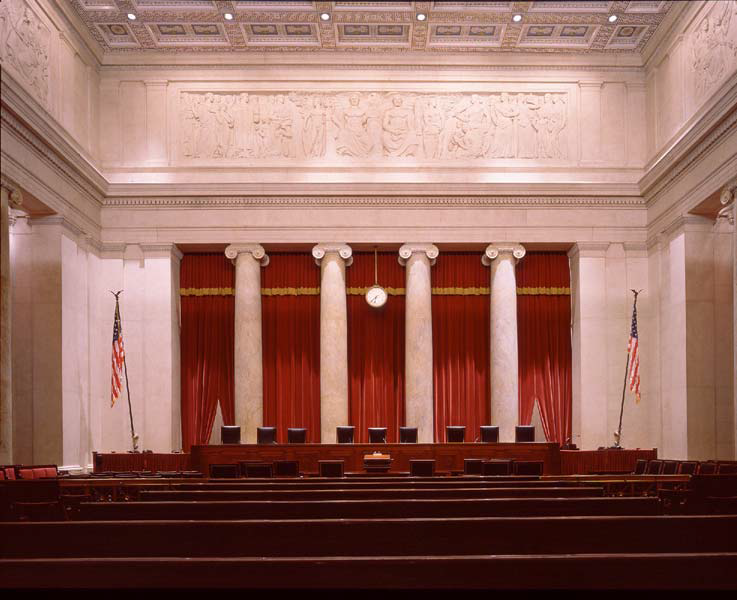
Office of the Curator • Supreme Court of the United States
The Courtroom showing the location of the East Wall Frieze above the Bench (c. 1998)
The East Wall Frieze - enlarged

Office of the Curator • Supreme Court of the United States
Sculptor Weinman designed these friezes to portray allegorical representations of law for the east and west walls.
The East Wall Frieze (above) is located directly above the Bench. At the center are two male figures: on the left is the Majesty of Law with a book of law at his side; to the right is the Power of Government who holds the fasces, an ancient Roman symbol of authority. According to a letter from Weinman to Gilbert describing the design for this frieze, the pylon carved with the Roman numerals I to X between the two central figures symbolizes the first ten amendments to the Constitution, also known as the Bill of Rights. Behind the central group, an American eagle spreads its wings.
Immediately to either side of the central figures are Wisdom, on the left, mostly nude and holding a lantern, and Statecraft, on the right, whose shield is emblazoned with the Scales of Justice.
Weinman described the figural group to the left, led by a judge holding a book of law, as the “The Defense of Human Rights and Protection of Innocence.” He called the group to right the “Safeguard of the Liberties and Rights of the People in Their Pursuit of Happiness.”
The South Wall Frieze

Office of the Curator • Supreme Court of the United States
Adolph A. Weinman’s
sculptures for the south and north walls depict great lawgivers.
The facing friezes begin on the South Wall, to the right of
visitors, with an allegorical figure for Fame. This procession
of historical lawgivers of the
- Fame
- Menes (c. 3200 bce) First King of the first dynasty of ancient Egypt. He unified Upper and Lower Egypt under his rule and is one of the earliest recorded lawgivers.
- Hammurabi (c. 1700s bce) King of Babylon, credited with founding the Babylonian Empire. He is known for the Code of Hammurabi, one of the earliest known legal codes.
- Moses (c. 1300s bce) Prophet, lawgiver, and judge of the Israelites. Mosaic Law is based on the Torah, the first five books of the Old Testament. Moses is depicted in the frieze holding two overlapping tablets, written in Hebrew, representing the Ten Commandments. Only Commandments six through ten are partially visible from along Moses’ beard. The first five Commandments are hidden behind his beard and robe to the right. Hebrew is written from right to left.
- Authority
- Solomon (c. 900s bce) King of Israel and renowned judge and wise man.
- Lycurgus (c. 800 bce) Legislator of Sparta. Lycurgus is credited with being one of the reformers of Sparta’s constitution.
- Solon (c. 638 - 558 bce) Athenian lawgiver. He was appointed archon, an officer of state, and was charged with remodeling the Athenian constitution in 594 bce. He was instrumental in codifying and reforming Athenian law.
- Light of Wisdom
- Draco (c. 600s bce) One of Solon’s legal predecessors in Athens. Around 620 bce, he committed an Athenian code of laws to paper for the first time.
- Confucius (551 - 478 bce) Chinese philosopher whose teachings stressed harmony, learning, and virtue. Within 300 years of his death, the Chinese State adopted his teachings as the basis for government.
- Octavian (63 bce -14 ce) or Augustus. First Emperor of the Roman Empire. He brought widespread reforms to many facets of Roman life and law.
- History
The West Wall Frieze

Office of the Curator • Supreme Court of the United States
According to Weinman, the West Wall Frieze is an allegorical representation of “Good Versus Evil.”
In this sculpture, the central female figures are Justice and Divine Inspiration. Leaning on a sheathed sword representing her might, Justice faces to the viewer’s right, staring down the forces of Evil. The winged figure of Divine Inspiration holds out the Scales of Justice.
Flanking these two figures are representations of Wisdom, to the left, with an owl perched on his shoulder, and Truth, to the right, holding a mirror and a rose.
Moving to the left from the central figures are the “Powers of Good”: Defense of Virtue, Charity, Peace, Harmony, and Security.
The “Powers of Evil,” moving to the right from the central group, are: Vice and Crime, Corruption, Slander, Deception, and Despotic Power.
The North Wall Frieze

Office of the Curator • Supreme Court of the United States
The frieze on the North Wall, to the left of visitors, is a procession of historical lawyers of the Christian era. This procession moves from right to left with allegorical figures interspersed.
- Philosophy
- Justinian (c. 483 - 565) Byzantine Emperor from 527 until his death. He ordered the codification of Roman Law and published Corpus Juris Civilis. This work was instrumental in preserving Roman law and encompassed what has become known as the Justinian Code.
- Muhammad (c. 570 - 632) The Prophet of Islam. He is depicted holding the Qur’an. The Qur’an provides the primary source of Islamic Law. Prophet Muhammad’s teachings also explain and implement Qur’anic principles.
- Charlemagne (c. 742 - 814) or Charles I (the Great). King of the Franks and Roman Emperor. He was a reformer of legal, judicial, and military systems. Under his leadership, most of Western Europe was united by 804 becoming the foundation for the Holy Roman Empire.
- Equity
- King John (1166 - 1216) born John Lackland. King of England from 1199 until his death. His barons forced him to have his seal affixed to the Magna Carta. This document, depicted in the frieze as a scrolled document in his hand, is regarded as the foundation of constitutional liberty in England.
- Louis IX (c. 1214 - 1270) King of France. He created the first court of appeals known as the “Curia Regis” or “King’s Court.”
- Hugo Grotius (1583 - 1645) or Huig de Groot. Dutch scholar, lawyer, and statesman. He is depicted holding De jure belli ac pacis (Concerning the Law of War and Peace), one of the first books on international law, which he wrote in 1625.
- Right of Man
- Sir William Blackstone (1723 - 1780) English law professor and jurist. He wrote Commentaries on the Law of England (1765 1769), which has had a major influence on English and American Law.
- John Marshall (1755 - 1835) Fourth Chief Justice of the United States, from 1801 to 1835. His 1803 opinion in Marbury v. Madison stated that the Supreme Court of the United States had the authority to determine the constitutionality of a law, establishing the power of judicial review for the Court.
- Napoleon (1769 - 1821) Emperor of France from 1804 to 1815. He ordered and directed the recodification of French Law into what became known as the Code Napoleon or Civil Code. Published in 1804, this code forms the basis for modern civil law.
- Liberty and Peace
and retrieved from www.supremecourt.gov/about/north&southwalls.pdf June 23, 2013.
All these photographs are from the Collection of the Supreme Court of the United States unless otherwise noted.
My descriptions are based on texts from the Office of the Curator • Supreme Court of the United States - updated: 10/1/2010 (East & West Walls) and 5/8/2003 (North & South Walls).
- Viewing the Outside of the Supreme Court Building -
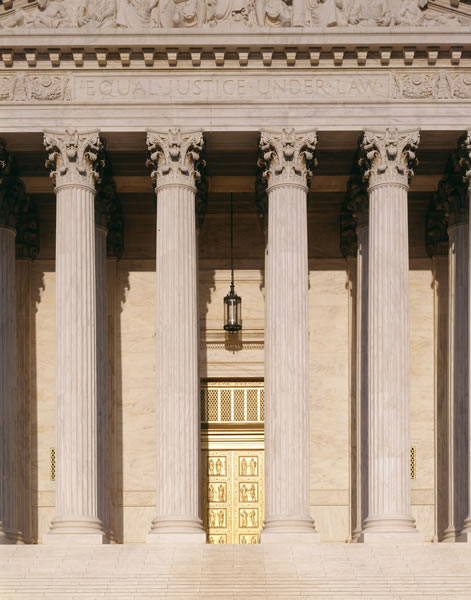 Office
of the Curator • Supreme Court of the United States
Office
of the Curator • Supreme Court of the United States
Views
of the building's main entrance on the west side, facing the
United States Capitol. "Equal Justice Under Law" is incised on
the architrave above the sixteen marble columns. Above this is
the pediment, filled with a sculpture group by Robert
Ingersoll Aitken
The Supreme Court Building from the East
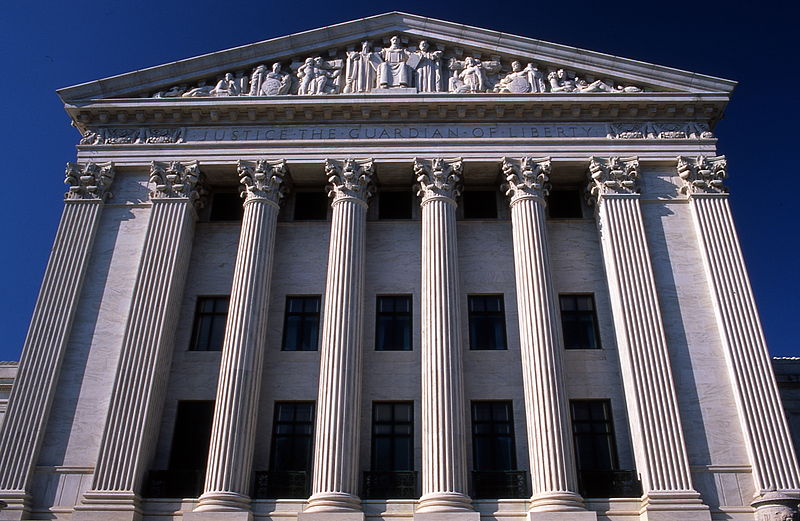
Office of the Curator • Supreme Court of the United States
The U.S. Supreme Court Building from the east: "Justice - The Guardian of Liberty"
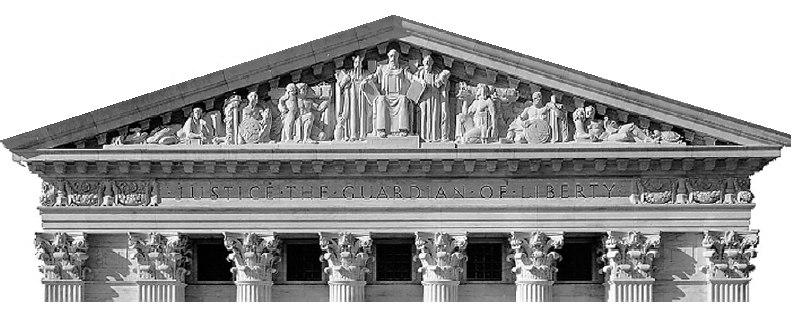
The building's eastern pediment by Hermon A. MacNeil
This view of the building's eastern pediment shows
a sculpture group by Hermon A. MacNeil
Cass Gilbert, the building’s architect, worked
closely with MacNeil from 1932 to 1934 to create the thirteen
symmetrically balanced figures above the Corinthian
portico. The central marble figures on this rarely noticed
eastern pediment depict the theme
The two tablets that Moses holds in his arms are blank, without inscription.
Allegorical figures on each side of the lawgivers represent functions of the Supreme Court. Sculptor MacNeil submitted the following description of his work to the Supreme Court Building Commission:
Law as an element of civilization was normally and naturally derived or inherited in this country from former civilizations. The "Eastern Pediment" of the Supreme Court Building suggests therefore the treatment of such fundamental laws and precepts as are derived from the East.
- Moses, Confucius and Solon are chosen as representing three great civilizations and form the central group of this Pediment.
- Flanking this central group -- on the left -- is the symbolical figure bearing the means of enforcing the law; on the right, a group tempering justice with mercy, allegorically treated. The “Youth” is brought into both these groups to suggest the “Carrying On” of civilization through the knowledge imbibed of right and wrong.
The next two figures with shields:
- Left -- The settlement of disputes between states through enlightened judgment.
- Right – Maritime and other large functions of the Supreme Court in protection of the United States.
The last figures:
- Left -- Study and pondering of judgments.
- Right -- A tribute to the fundamental and supreme character of this Court.
- Finale -- The fable of the "Tortoise and the Hare.” [The tortoise is on the viewers' right, the hare on the left.]
(Hermon A. MacNeil Virtual Gallery & Museum,
"Moses, Confucius, and Solon at Supreme Court")
The two lawgivers, Confucius and Solon, are not facing Moses in the middle. All three lawgivers are depicted facing forward in full frontal views. However, the allegorical figures who flank the three lawgivers are indeed facing towards the middle, but they are looking in the direction of all three men, not just toward Moses.
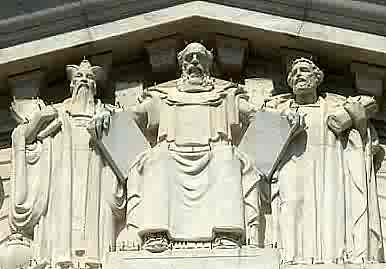
MacNeil Virtual Gallery
Lawgivers Confucius, Moses, and Solon (left to right)
(pegs prevent pigeons from roosting)
The Fable of the “Tortoise and the Hare”
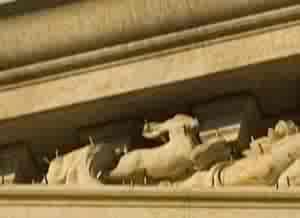
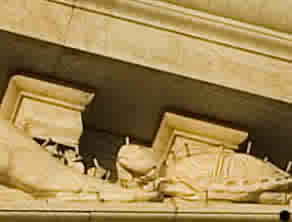
MacNeil Virtual Gallery
Hare on the left (south corner) ~ Tortoise on the right (north corner)
At the corners of the East Pediment of the U.S.
Supreme Court Building, Hermon MacNeil placed the figures of a
tortoise and a hare as "bookends." These two marble
carvings, the smallest pair of groupings in his work
In addition to the . . .
twelve-foot figures of the greatlawgivers . . . sculptor [MacNeil] is completing the decoration with symbolical figures and design.In this connection, the design will include the figures of the tortoise and the hare. Whether the august Justices of the Supreme Court will fancy the allusion to the law as a solemn, plodding tortoise, cannot be known. But, it must be remembered, the tortoise did reach the goal eventually. (February 27, 1933)
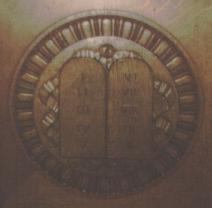
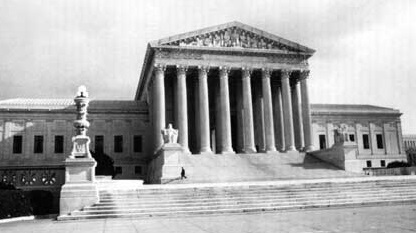
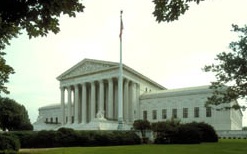
 East
East